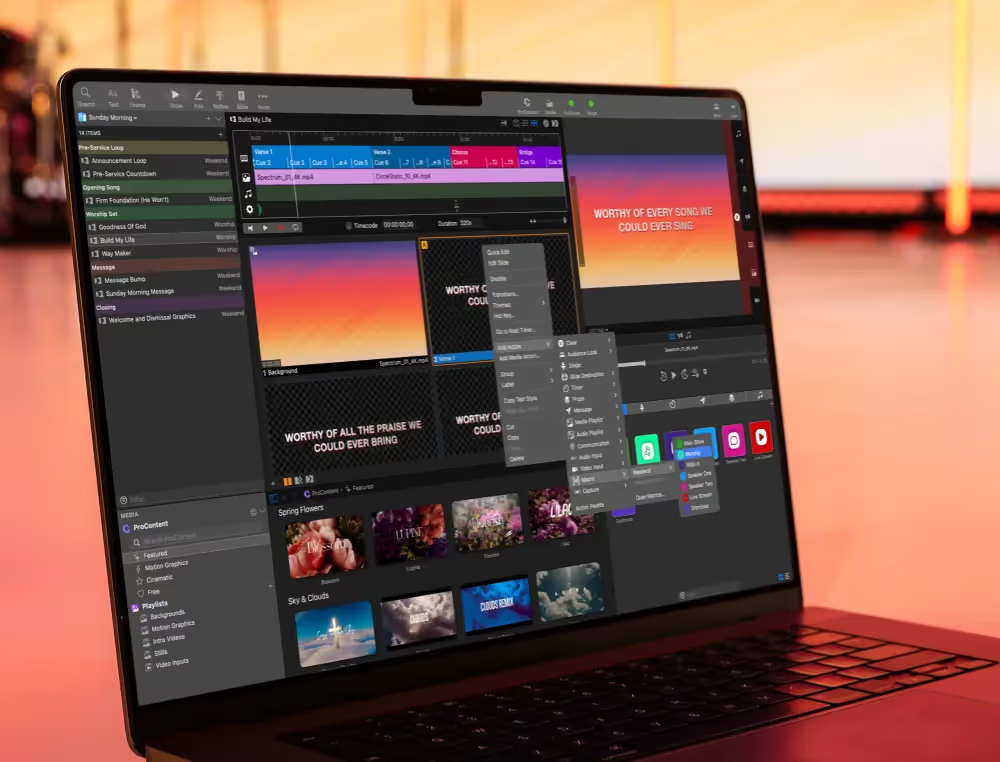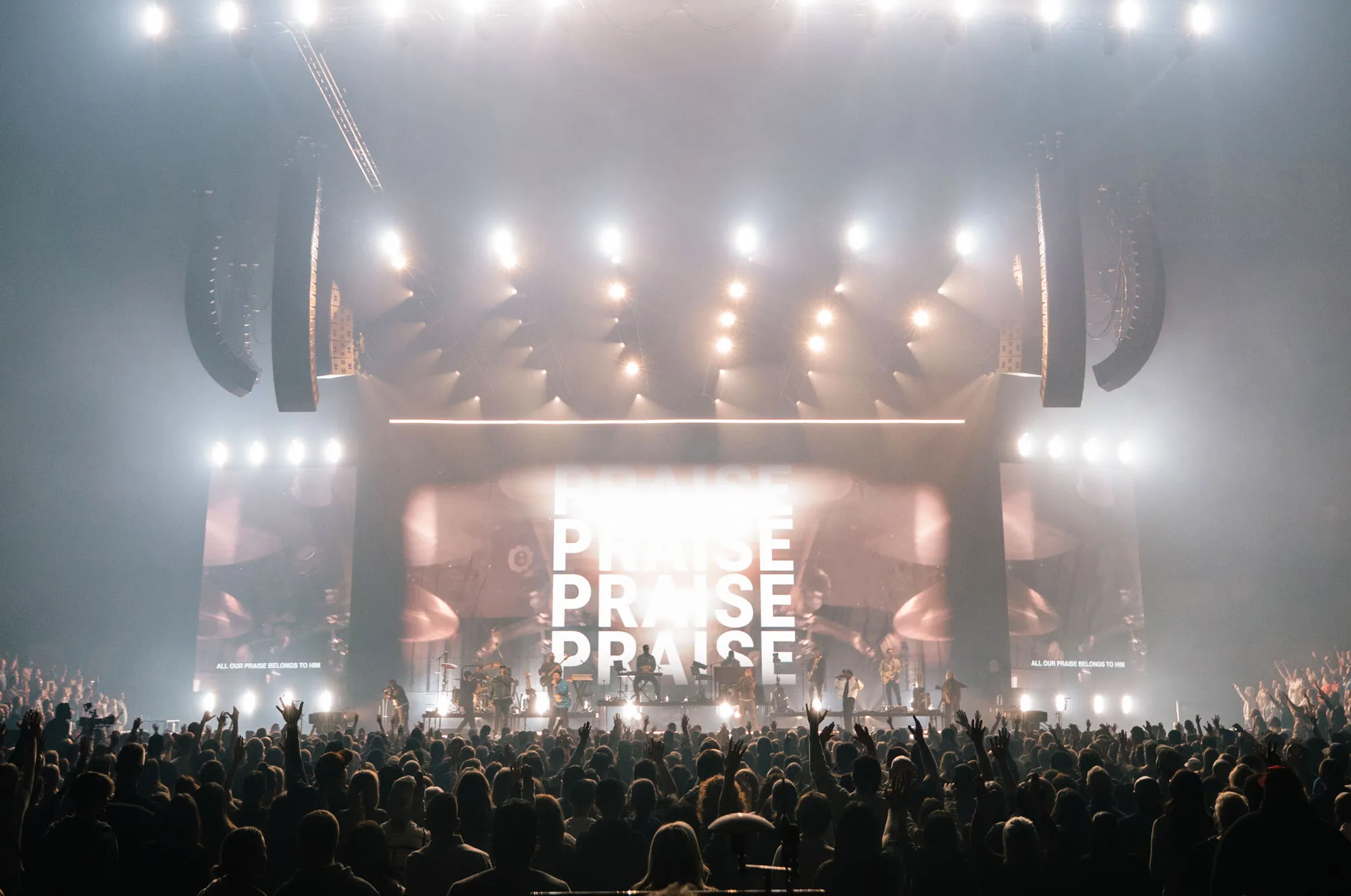Learn more Introducing the ProPresenter Lyric Banner!
Daystar Church is a large multi-site church located in Alabama with impressive stage designs and creative processes. We caught up with their Production Manager, Dennis Carr, to get some insight into their thought process when it comes to designing a new stage look.
Here’s the key questions that Dennis uses when approaching the creative process.

Capability
What is your capability? It’s easy to shoot for the stars when considering what look you want to go with for your next stage design. However, capability is one of the most important aspects to understand before you put time and effort into creating potential designs.
At Daystar Church, our capabilities are evolving as we grow yet also clear and practical. At our main broadcast campus, we run 3 projection screens with Epson ProL1505 UH projectors. Our current auditorium was actually built to be a gymnasium after a later renovation, however, we have used it as our worship auditorium for the past 10 years. This brings about its own challenges when it comes to stage designing. On the contrary, it sets clear lines on what our capabilities are. I know that no matter what we need to run IMAG on each of our side screens due to how large our room is and also the layout of it. Our seating spans in a three quarter circle around our stage (think Pacman). Knowing this, all potential stage designs start there.
Broadcast gear also comes into play at this stage. We utilize ProPresenter 7 with a Decklink Duo 2 on a Mac Mini with a M1 chip to get content to destinations. This allows us to achieve multiple different looks and routing capabilities.
Lighting-wise, we have certain fixtures that get utilized each stage design (we don’t keep a ton of fixtures in storage). Included in these are Chauvet Rogue R1 Beams and R1 washes. I have utilized these fixtures in each stage design that I have built so I consider these part of the basic package when building out new stage designs.
What are the capabilities of your team? The more hands helping, the better. My team has pulled off a complete stage design in as little as 3 days. A lot of energy drinks were consumed. A key factor that I have learned is that you don’t always need your best guys helping you but the most willing guys will get the most done. Nothing makes me prouder than raising up volunteers that I can hand projects off to, go to a meeting, and come back and it is executed with excellence. It is so easy to overwork yourself during stage design weeks but with a well equipped team, the workload is shared and not so heavy.

Budget
What does your budget allow? Budget is without a doubt the start and end of any stage design. Budget, for me, gives me the borders needed when considering new stage designs. What fixtures are you able to afford? What fixtures could you sell to buy different fixtures? What cabling do you need to purchase? What type of gear do you need to purchase to pull off your design?
All of these are questions that I ask myself when considering multiple stage designs. If your church does Budget Requests at the beginning of each year, I would recommend requesting a little bit extra than you know you need to cover those last minute hardware store trips to grab a certain piece of equipment that you need to complete your stage design.

Concept
What concept are you going for? For me, I always get with our creative team to see what the “look” is going to be for this quarter of the year across all campuses. It is not the heaviest factor in stage design but it is a big factor. If the creative team is going for a more simplified look then I want the stage to reflect that, if they are going for more of an elaborate look then the stage should reflect that also.
Usually for each stage design there are multiple concepts that I consider before presenting the final design to our Lead Pastor. Sometimes I build the concepts in a 3D software and sometimes I just vocalize the concepts. From that meeting, the final concept is decided on and then I present the concept to my team that is going to help me execute it.

Execution
The most difficult part of any stage design. There are A TON of logistics that go into the execution of the design. Time frame and team are of the more important ones. Most stage designs that we do, we have from Monday to Friday to tackle them, however, there have been times where we’ve had to tackle a stage design in as little as three days and times like that are when it helps to have a really good team.
Being a fully volunteer ran Production Department besides myself, it is crucial to raise up your volunteers to a level where they feel ownership for the Production Department. Don’t be afraid to accept input and critiques from your volunteers. That can be a difficult thing to comprehend but it can be completely game changing. I have certain volunteers that own certain areas more than others. For instance, we have been in the middle of a stage design before and a volunteer will offer up a change in the design and we have taken it and ran with the recommendation.
For our stage designs, I will be on site as more of a project manager role to make sure equipment is being placed in the right places and the team is executing the design on time. After we install all gear and check all rigging and alignments, we will start everything up and run all gear to work out any errors. Part of this is re-addressing fixtures and creating new effects for any new fixtures and also any existing fixture that got moved to a different area. We keep a gear sheet that is constantly changing with any stage design that we do.
If you have a surplus of gear that isn’t being used for that certain design, I recommend having a system down to keep up with inventory. We use a QR code software that lets you put a sticker on each piece of gear and input in the software what the gear is and where it is stored. (example: Chauvet Rogue R1 Beam – North End Warehouse) This system has saved us a ton of time. Remember to celebrate with your team after install weeks, it can be long hours and hard work on your team, a little bit of appreciation and celebration goes a very long way after a long week like that.

Final Thoughts
When thinking of your next stage design, try to not get lost in what other churches are doing. Watch the trends but don’t get lost in it. There are churches of all different sizes and budgets and what works for them may not work for you, try to be innovative. A hurdle that I had to overcome when I first got into the Church Production world was being caught up in what other, bigger churches were doing. I enjoy following the trends but I also understand what is reasonable within my budget. My team has pulled off some pretty incredible designs throughout the years and the best part of them all is that each was different and each was innovative. Happy designing friends!
Learn more about the features and capabilities of RenwedVision’s house of live worship software here.
By subscribing, you agree to our Terms and Conditions.
Experience the power of ProPresenter
Take your production to the next level with ProPresenter's intuitive suite of tools.

Stay Updated with Our Newsletter
Get the latest news, updates, and exclusive offers delivered straight to your inbox.

Questions?
Browse our FAQs or our Knowledge base that we’ve made to answer your questions. Need additional help? Connect with a support team agent!


.png)
.avif)